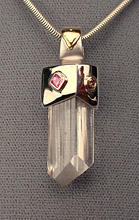
First discovered in Danbury, Connecticut, in 1839, this gem has been found and mined in Japan, Russia, Mexico, Burma, and Madagascar. It ranges from milky translucent white, to transparent pieces of colorless, light yellow, tan, and rarely, very pale pink.
The type locality of the US deposit which was named for the town nearby, has long since been covered over, and made inaccessible by the growth of this now rather large community. Pieces that actually originated from this location are now prized by collectors.
Danburite is found in metamorphosed limestones and low temperature hydrothermal veins, but few its numerous locales yield either impressive crystals for the mineral collector, or transparent pieces of sufficient size to facet. Joel Arem in his "Color Encyclopedia of Gemstones" states that although the mineral itself is relatively common, large, facetable pieces are rare. The crystals often have a distinctive wedge-shaped habit and nicely terminated ones are beautiful to see. The best crystals, mostly translucent or milky white have historically come from mines in Central Mexico. Although similar in shape and color to topaz crystals, Danburite can be distinguished by its lack of cleavage compared to the strong cleavage seen in topaz.

Likewise, cut gems have a luster and refractive index very close to that of white, yellow and brown topaz, but gemologically these two species can be separated by the difference in specific gravity (topaz is denser) and birefringence, which is higher in topaz. The distinctive blue fluorescence of many Danburites when exposed to ultraviolet light, is also an indentification criterion.
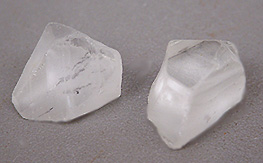
Although it is not common enough to become a major commercial jewelry stone, there is enough material for gem collectors, and adventurous jewelry lovers to bring this lovely and under appreciated gem into their collections. Danburite is also sought out by those who are interested in the metaphysical properties ascribed to gems and crystals.
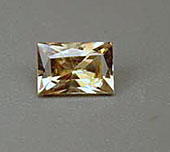

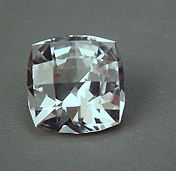
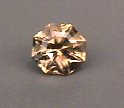
With no cleavage, good toughness and a hardness of 7; Danburite makes an excellent jewelry stone, that surpasses quartz and beryl in brilliance. Its modest dispersion means that although very brilliant, cut gems lack "fire"(spectral color flecks). Due to some heat sensitivity (the heat from a jewelers torch will fuse it), it is best not to subject this gem to steam cleaning, but otherwise, it requires no special care, and can be used in all applications, including rings and bracelets. There are no known enhancements, synthetics or imitations on the market.
The tried and true value factors for gems in general apply to this species very well. All other things being equal, larger, cleaner, and better cut stones are worth more per carat. The only caveat here, might be that a noticeably pink stone (most as so pale as to be essentially colorless) would surpass the colorless, yellows, and browns in value. In my opinion, for a relatively rare, brilliant, and quite wearable gem, prices are low enough to represent a real gem bargain.